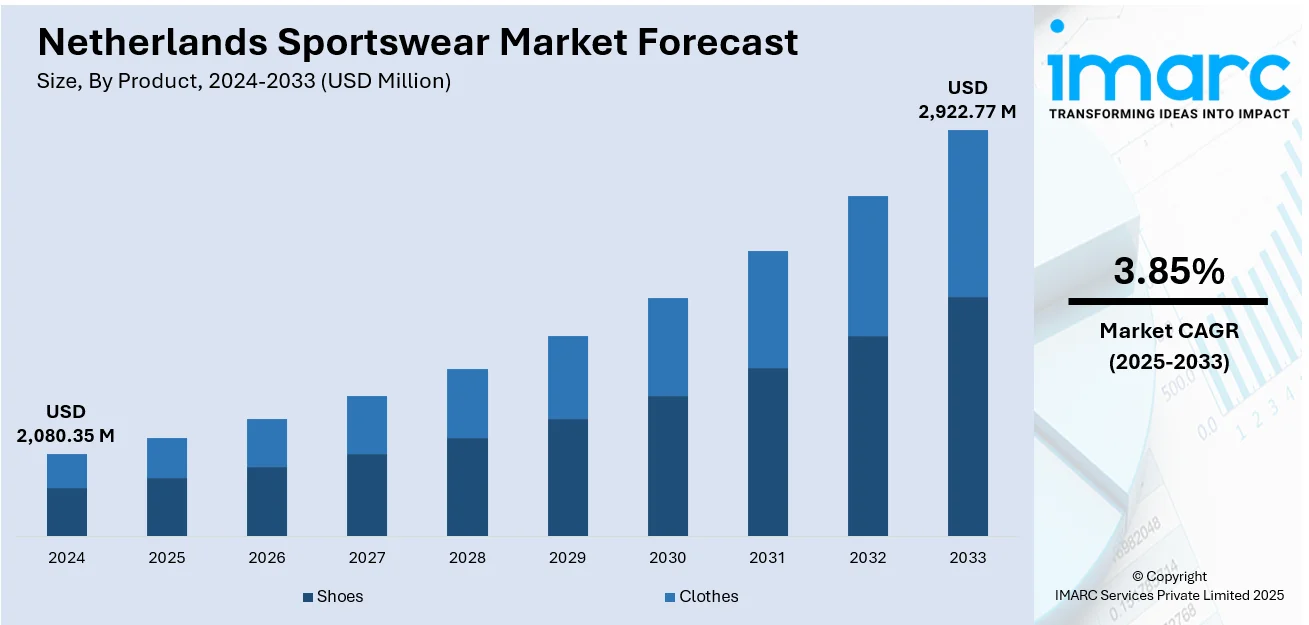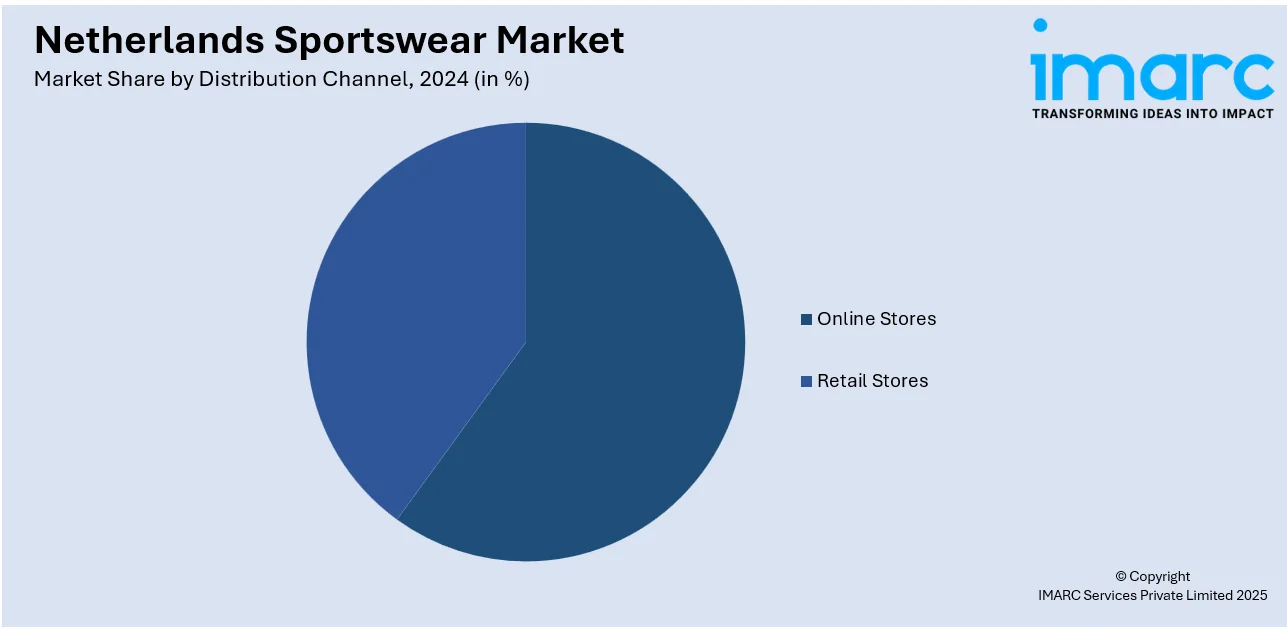
Netherlands Sportswear Market Size, Share, Trends and Forecast by Product, Distribution Channel, End User, and Region, 2025-2033
Netherlands Sportswear Market Overview:
The Netherlands sportswear market size reached USD 2,080.35 Million in 2024. Looking forward, the market is expected to reach USD 2,922.77 Million by 2033, exhibiting a growth rate (CAGR) of 3.85% during 2025-2033. The market is experiencing steady growth, fueled by increasing health consciousness, rising inclination toward athleisure fashion, and a strong sporting culture. Consumers are also embracing both international and local brands offering performance and lifestyle wear. Online retail and sustainable product lines are also gaining traction, contributing to the expanding Netherlands sportswear market share.
|
Report Attribute
|
Key Statistics
|
|---|---|
|
Base Year
|
2024
|
|
Forecast Years
|
2025-2033
|
|
Historical Years
|
2019-2024
|
| Market Size in 2024 | USD 2,080.35 Million |
| Market Forecast in 2033 | USD 2,922.77 Million |
| Market Growth Rate 2025-2033 | 3.85% |
Netherlands Sportswear Market Trends:
Health and Wellness Awareness
Rising health consciousness among Dutch consumers is a primary driver of the sportswear market. A growing number of individuals are participating in fitness routines such as running, cycling, and gym workouts to maintain physical and mental well-being. This shift is supported by national campaigns and local government programs that promote active lifestyles. Additionally, wearable fitness technology and mobile health apps have made it easier to track progress, encouraging continuous engagement. As more people adopt fitness-focused lifestyles, the demand for high-quality, performance-enhancing sports apparel is accelerating. Sportswear is no longer limited to athletic purposes; it’s now viewed as an essential part of a healthy lifestyle, blending function with comfort and driving consistent market growth across both active and casual segments. This cultural shift reinforces long-term opportunities for brands focused on wellness-driven product innovation.

To get more information on this market, Request Sample
Rising Popularity of Athleisure
The athleisure trend, fusing athletic apparel with everyday fashion, is rapidly gaining momentum across the Netherlands, thereby driving the Netherlands sportswear market growth. Consumers, particularly Millennials and Gen Z, favor versatile outfits that can transition from casual wear to light physical activity. This lifestyle shift, fueled by the rise of remote work and flexible dress codes, has pushed brands to design aesthetically pleasing yet functional sportswear. Dutch consumers also value sustainability and innovation, prompting demand for eco-friendly athleisure made from recycled or organic materials. Influencer endorsements and fashion-forward collaborations further popularize this segment. Retailers, both physical and online, are expanding athleisure offerings to capture growing interest. As sportswear continues to cross into mainstream fashion, the line between activewear and casualwear is blurring, expanding usage occasions and strengthening consumer loyalty.
E-Commerce Expansion and Digital Influence
Digital transformation is reshaping how Dutch consumers purchase sportswear. The strong penetration of smartphones, widespread internet access, and digitally savvy population make online channels a critical growth engine. Major brands and retailers are enhancing their e-commerce platforms, offering virtual fitting rooms, AI-based product recommendations, and seamless delivery options. Social media platforms like Instagram and TikTok play a significant role in shaping purchase decisions through influencer campaigns and interactive content. Additionally, fitness apps and wearable tech integrate with brand ecosystems, increasing user engagement and product visibility. Flash sales, limited-edition drops, and personalized promotions drive impulse purchases online. As convenience and digital experience take priority, online sales are outpacing traditional retail, making e-commerce not just a channel but a strategic pillar of market expansion.
Netherlands Sportswear Market Segmentation:
IMARC Group provides an analysis of the key trends in each segment of the market, along with forecasts at the country and regional levels for 2025-2033. Our report has categorized the market based on product, distribution channel, and end user.
Product Insights:
- Shoes
- Clothes
The report has provided a detailed breakup and analysis of the market based on the product. This includes shoes and clothes.
Distribution Channel Insights:

- Online Stores
- Retail Stores
A detailed breakup and analysis of the market based on the distribution channel have also been provided in the report. This includes online stores and retail stores.
End User Insights:
- Men
- Women
- Kids
A detailed breakup and analysis of the market based on the end user have also been provided in the report. This includes men, women, and kids.
Provincial Insights:
- Noord-Holland
- Zuid-Holland
- Noord-Brabant
- Gelderland
- Utrecht
- Others
The report has also provided a comprehensive analysis of all the major regional markets, which include Noord-Holland, Zuid-Holland, Noord-Brabant, Gelderland, Utrecht, and others.
Competitive Landscape:
The market research report has also provided a comprehensive analysis of the competitive landscape. Competitive analysis such as market structure, key player positioning, top winning strategies, competitive dashboard, and company evaluation quadrant has been covered in the report. Also, detailed profiles of all major companies have been provided.
Netherlands Sportswear Market News:
- In June 2025, Nike Football unveiled the much-awaited 2025 Netherlands National Team Kit for the Women’s EURO, designed to embody cutting-edge innovation, empower individuality, and enhance on-field performance. This bold release underscores Nike’s commitment to advancing the women’s game through thoughtful design and athletic excellence.
Netherlands Sportswear Market Report Coverage:
| Report Features | Details |
|---|---|
| Base Year of the Analysis | 2024 |
| Historical Period | 2019-2024 |
| Forecast Period | 2025-2033 |
| Units | Million USD |
| Scope of the Report |
Exploration of Historical Trends and Market Outlook, Industry Catalysts and Challenges, Segment-Wise Historical and Future Market Assessment:
|
| Products Covered | Shoes, Clothes |
| Distribution Channels Covered | Online Stores, Retail Stores |
| End Users Covered | Men, Women, Kids |
| Regions Covered | Noord-Holland, Zuid-Holland, Noord-Brabant, Gelderland, Utrecht, Others |
| Customization Scope | 10% Free Customization |
| Post-Sale Analyst Support | 10-12 Weeks |
| Delivery Format | PDF and Excel through Email (We can also provide the editable version of the report in PPT/Word format on special request) |
Key Questions Answered in This Report:
- How has the Netherlands sportswear market performed so far and how will it perform in the coming years?
- What is the breakup of the Netherlands sportswear market on the basis of product?
- What is the breakup of the Netherlands sportswear market on the basis of distribution channel?
- What is the breakup of the Netherlands sportswear market on the basis of end user?
- What is the breakup of the Netherlands sportswear market on the basis of region?
- What are the various stages in the value chain of the Netherlands sportswear market?
- What are the key driving factors and challenges in the Netherlands sportswear market?
- What is the structure of the Netherlands sportswear market and who are the key players?
- What is the degree of competition in the Netherlands sportswear market?
Key Benefits for Stakeholders:
- IMARC’s industry report offers a comprehensive quantitative analysis of various market segments, historical and current market trends, market forecasts, and dynamics of the Netherlands sportswear market from 2019-2033.
- The research report provides the latest information on the market drivers, challenges, and opportunities in the Netherlands sportswear market.
- Porter's five forces analysis assist stakeholders in assessing the impact of new entrants, competitive rivalry, supplier power, buyer power, and the threat of substitution. It helps stakeholders to analyze the level of competition within the Netherlands sportswear industry and its attractiveness.
- Competitive landscape allows stakeholders to understand their competitive environment and provides an insight into the current positions of key players in the market.
Need more help?
- Speak to our experienced analysts for insights on the current market scenarios.
- Include additional segments and countries to customize the report as per your requirement.
- Gain an unparalleled competitive advantage in your domain by understanding how to utilize the report and positively impacting your operations and revenue.
- For further assistance, please connect with our analysts.
 Request Customization
Request Customization
 Speak to an Analyst
Speak to an Analyst
 Request Brochure
Request Brochure
 Inquire Before Buying
Inquire Before Buying




.webp)




.webp)












